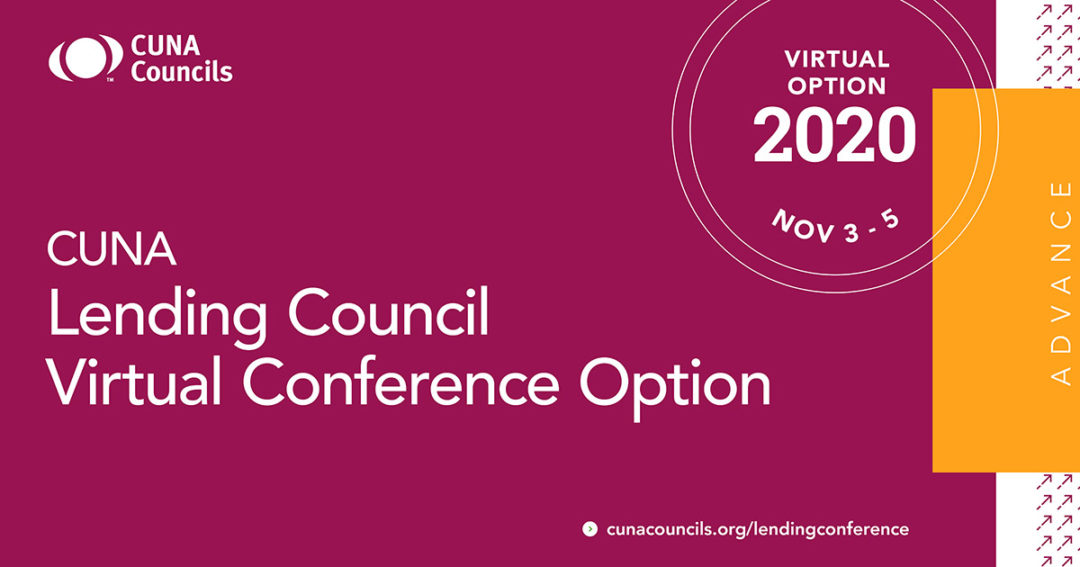
Lending during a pandemic
COVID-19 response, lending talent, future of business lending top roundtable discussions.
When the coronavirus (COVID-19) pandemic struck earlier this year, lending departments across the country found themselves pivoting to remote work environments that still allowed them to engage with members and meet their borrowing needs.
“It’s been a challenge,” says Jon Paukovich, vice president of mortgage lending at $6.9 billion asset Ent Credit Union in Colorado Springs, Colo., and a member of the CUNA Lending Council Executive Committee. “The hardest part has been keeping the cohesiveness and culture of the group together.”
Responding to COVID-19 was one of many trends discussed during a series of panel discussions on consumer, mortgage, and member business lending (MBL) during the CUNA Lending Council Virtual Conference.
Mortgage lending
In addition to responding to COVID-19, mortgage lenders face the challenges of retaining staff, increasing diversity, and attracting young professionals to this area of lending.
“Diversity is a topic across our credit union as whole, but especially in mortgage banking,” Paukovich says. “Our talent pool is drying up.”

Clockwise from left: Tracy Ashfield, Ashfield & Associates; Sue Dunbar, Hanscom Federal Credit Union; Jon Paukovich, Ent Credit Union.
Challenges mortgage leaders face include the threat of losing employees to competitors, who may offer higher salaries or benefits such as permanent work from home after the pandemic ends, says Susan Dunbar, chief lending officer at $1.6 billion asset Hanscom Federal Credit Union at Hanscom Air Force Base in Massachusetts.
Promoting candidates from within the credit union to fill certain roles—such as appraisers—also presents obstacles. The training requirements and certifications needed for appraisal professionals are challenging, and credit unions often don’t have the resources or staff available to mentor and train these new individuals, Paukovich says.
Mortgage professionals also are striving to make the mortgage process completely digital from the application through closing. This has become more important during COVID-19 and will remain a priority in the future.
“This isn’t a flash in the pan or a reaction to the pandemic,” says Tracy Ashfield, president of Ashfield & Associates. “This is forever changing our industry.”
Consumer lending
On the consumer loan side, lenders are seeing increases in indirect auto lending, says Jeremy Pinard, vice president of consumer lending at $13 billion asset Alliant Credit Union in Chicago and a member of the CUNA Lending Council Executive Committee.
But he notes there has been a decrease in credit card balances, which he attributes to people not traveling during the pandemic. Even with holiday promotions and robust online shopping, Pinard believes balances will remain low.

From left: Dan Picard, Hanscom Federal Credit Union; Jeremy Pinard, Alliant Credit Union.
“Credit card balances will really struggle until people start traveling again,” he says. “That was a big expense; people going on vacation.”
Credit unions saw a spike in requests for skipped payments during the initial wave of COVID-19. When members requested second deferments, credit unions usually asked for more documentation to gather proof of hardship.
Alliant Credit Union has granted 11,000 deferments, and Pinard says 83% of these members are making regular payments. Alliant receives about 150 requests a month for deferments, but this is a substantial drop since March.
The panel also discussed the future of private student loans in the wake of COVID-19.
“The college landscape is going to change,” Pinard says. “Know why you’re getting into student loans.”
Member business lending
Even during a pandemic, lenders are looking to grow their MBL portfolios. And while businesses have put some projects on hold during COVID-19, there continues to be demand.
“We saw some projects go on pause, but we continue to grow our portfolio,” driven partly by low rates, says Ethan Nelson, vice president of credit administration at $2.3 billion asset Oregon Community Credit Union in Eugene, Ore., and a member of the CUNA Lending Council Executive Committee. “Overall, we’re seeing demand grow. We’re just being a little more careful with what we’re doing, looking at [the business’] cash flow, and making sure it’s still there.”

Clockwise from left: Frank Perez, University Credit Union; Ethan Nelson, Oregon Community Credit Union; Kevin Nafziger, Park View Federal Credit Union; and Herb White, Sharonview Federal Credit Union.
Herb White, chief lending officer at $1.7 billion asset Sharonview Federal Credit Union in Indian Land, S.C., has some concerns about commercial real estate. “With more workers staying home, the demand for retail/office space is dropping, and that has a trickle-down effect on valuations.”
At the same time, White sees opportunities in the service industry, professional businesses, and healthcare.
Like others, business lenders have had to shift to virtually connecting with borrowers.
“I was an old believer in the handshake, but I’m pleasantly surprised with the amount of collaboration, insight, and work we’re getting from this environment,” White says. “This will have a permanent change in how we work with business members in the future.”
► Click here for more conference coverage from CUNA News. Learn more about the CUNA Lending Council, a member-led professional society for credit union executives, at cunacouncils.org.